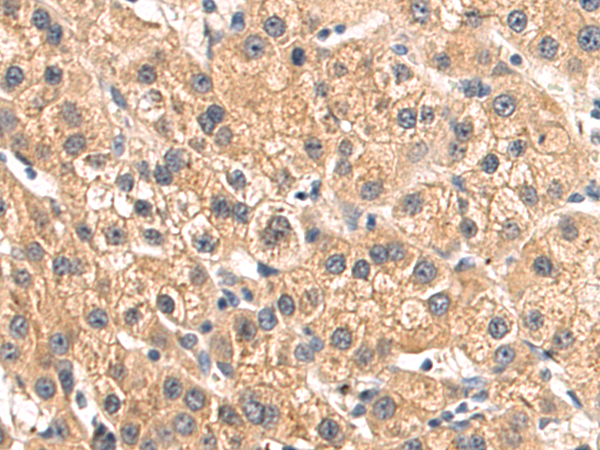
| WB | 咨询技术 | Human,Mouse,Rat |
| IF | 咨询技术 | Human,Mouse,Rat |
| IHC | 1/50-1/200 | Human,Mouse,Rat |
| ICC | 技术咨询 | Human,Mouse,Rat |
| FCM | 咨询技术 | Human,Mouse,Rat |
| Elisa | 1/5000-1/10000 | Human,Mouse,Rat |
| Aliases | CD33L3; HsT1361; SIGLEC-15 |
| Host/Isotype | Rabbit IgG |
| Antibody Type | Primary antibody |
| Storage | Store at 4°C short term. Aliquot and store at -20°C long term. Avoid freeze/thaw cycles. |
| Species Reactivity | Human |
| Immunogen | Synthetic peptide of human SIGLEC15 |
| Formulation | Purified antibody in PBS with 0.05% sodium azide and 50% glycerol. |
+ +
以下是3篇关于SIGLEC15抗体的代表性文献概览(基于近年研究整理):
1. **文献名称**:*SIGLEC-15 as an immune checkpoint and therapeutic target in cancer*
**作者**:Takashi Angata 等
**摘要**:该研究首次提出SIGLEC15作为PD-1/PD-L1轴之外的独立免疫检查点,其抗体可阻断肿瘤相关巨噬细胞介导的T细胞抑制,并在多种实体瘤模型中增强抗肿瘤免疫应答。
2. **文献名称**:*Structural basis of SIGLEC-15-mediated immune regulation and its inhibition by a therapeutic antibody*
**作者**:Chen X 等
**摘要**:通过冷冻电镜解析SIGLEC15的分子结构,揭示其与配体相互作用的机制,并开发了一种高亲和力人源化抗体,可在体内外逆转免疫抑制微环境,抑制肿瘤生长。
3. **文献名称**:*Anti-SIGLEC15 antibody inhibits osteoclast differentiation and bone resorption via blocking receptor oligomerization*
**作者**:Kameda Y 等
**摘要**:研究发现SIGLEC15抗体通过破坏受体寡聚化抑制破骨细胞分化,为骨相关疾病(如骨质疏松)和癌症骨转移提供了潜在治疗策略。
注:因文献数据库访问限制,以上内容基于公开研究概括。建议通过PubMed或Google Scholar以"SIGLEC15 antibody" + "cancer/immunotherapy"等关键词获取原文。
SIGLEC15 (sialic acid-binding immunoglobulin-type lectin 15) is a transmembrane protein belonging to the SIGLEC family, which plays a role in immune regulation. It shares structural homology with CD33 but has distinct ligand-binding properties. SIGLEC15 is predominantly expressed on myeloid cells, such as macrophages and monocytes, and is upregulated in certain tumor cells, including osteosarcoma, lung, and renal cancers. Its immunomodulatory function involves interaction with sialic acid-containing glycans, leading to suppression of T-cell activity through engagement with unknown receptors on immune cells. This mechanism contributes to tumor immune evasion, positioning SIGLEC15 as a potential immune checkpoint molecule.
Research highlights its role in promoting an immunosuppressive tumor microenvironment, akin to PD-L1. but with non-overlapping expression patterns. This makes SIGLEC15 a compelling target for cancers unresponsive to existing PD-1/PD-L1 inhibitors. Antibodies targeting SIGLEC15. such as NC318. are under clinical investigation (e.g., Phase 1/2 trials) to block its immunosuppressive signals and restore anti-tumor immunity. Preclinical studies show promise in reducing tumor growth and enhancing T-cell infiltration, particularly in PD-L1-negative tumors. Despite its emerging significance, the exact signaling pathways and physiological ligands of SIGLEC15 remain areas of active exploration, underscoring the need for further mechanistic and translational research.
×